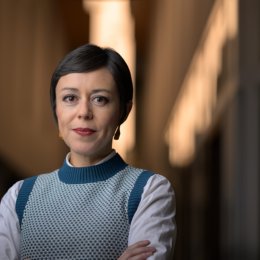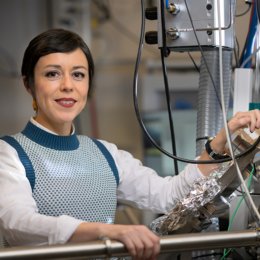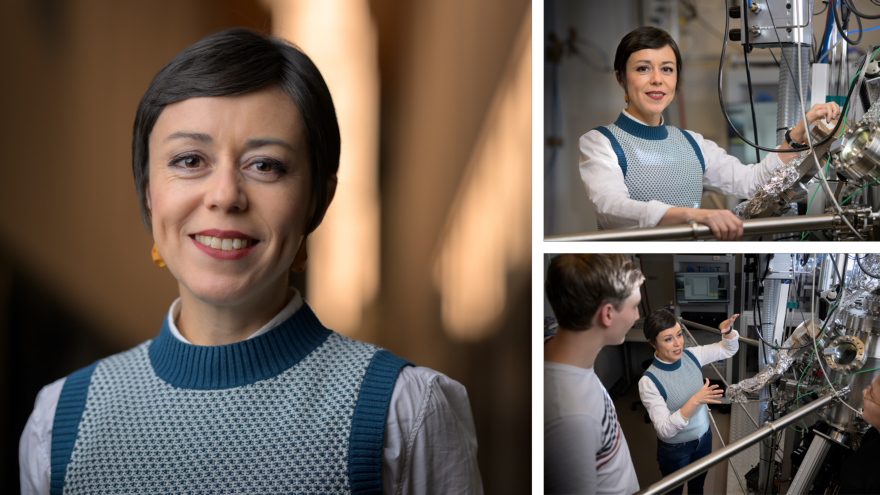new optoelectronic materials for solar cells
Completely transparent electronics and efficient solar cells require new types of materials that may not yet exist. Professor Monica Morales-Masis investigates a whole range of emerging optoelectronic materials, from inorganic to hybrid organic-inorganic semiconductors.
The ultimate goal is to make energy materials that are either more efficient, cheaper or that can be produced from abundant elements instead of scarce materials. As a materials scientist, Monica Morales-Masis works at the intersection of physics, chemistry and engineering, to study and develop new materials for optoelectronics, like solar cells and touch screen technology.
'We are looking for materials that are suitable for use in future solar cells,' she says. 'Currently there is a lot of interest in metal halide perovskites, which are hybrid (organic-inorganic) semiconductors that are very efficient at absorbing sunlight and converting it into electricity. Although these materials are cheap and relatively easy to produce, they can be unstable and often contain toxic elements, like lead. We are developing new ways to grow these materials and control their microstructure and we are exploring new materials compositions that absorb light with enough efficiency for use in solar cells, but without the drawback of the current materials.'
For this, Morales-Masis and her team demonstrated the use of pulsed laser deposition to produce thin layers of hybrid metal halide perovskites from the vapor-phase, making these materials without the use of toxic solvents. The team also studies transparent conducting materials, exploring the best tradeoff between high transparency and high electrical conductivity for use as electrodes for anything from touchscreens to OLEDs or solar cells. To find new combinations of materials, the researchers are literally scanning large parts of the periodic table to discover promising non-critical materials for transparent electrodes. Although the process of material discovery can be done with computer models, lab work is essential to actually create the chosen materials, investigate their fundamental properties and show their performance in a device.
In her free time Morales-Masis likes to paint, and she regularly takes this creative side of hers to work. 'Because we aim to create materials that may not yet exist, we have to ‘dare’ at times and try something completely new,' she says, pointing out that when she started making hybrid materials with laser-deposition, many researchers thought it would not work. 'By now we have shown that it can deliver efficient solar cell devices.'
'However, being creative and thinking out of the box must always be in balance with a solid scientific knowledge and the goal of your research, which in our case is improving the solar cells of the future,' says Morales-Masis, who recently received an ERC proof of concept grant for further exploring fabrication methods for hybrid halide perovskite materials. 'We will use our knowledge on pulsed laser deposition of halide perovskites to develop a sputtering coating process that will meet industrial requirements,' she says. 'This will be interesting for Perovskite-silicon tandem solar cells and bring us closer to our goal of eventually creating materials that will enable energy devices that are more efficient, sustainable and made from abundant materials.'
Education
Although she claims to be much more passionate about research, Morales-Masis does like her educational tasks. 'I really enjoy supervising students,' she says. 'I currently have five PhD students that I am very proud of. They make the real research results happen. They bring and share their own ideas to the team and do great at presenting their research, which I think is very important.' Her research group has a lot of room for bachelor and master students as well as external visitors from around the world. She puts a lot of effort into making the group work as a team, in which everyone is motivated to tackle their scientific problems together. Being responsible for teaching about materials in several advanced bachelor and master courses, Morales-Masis values simplicity in her lessons. 'I always try to start from a bigger picture and explain concepts in simple words. That makes teaching rather time consuming at times, but very rewarding as well,' she says.
About Monica Morales-Masis
Monica Morales-Masis studied Physics in Costa Rica and the United States. After obtaining her Master’s degree at Wright State University, she came to Europe. She did a PhD in Condensed Matter Physics at Leiden University and worked in Switzerland as a postdoc and subsequently team leader in the field of Photovoltaics at the École Polytechnique Fédérale de Lausanne (EPFL). Switching from condensed matter research to solar cells required switching fields, but Morales-Masis did not see that as a problem. 'When trying something new you might just discover your passion,' she says.
In 2018 Morales-Masis acquired a tenure track position in Twente, where she now is professor in Optoelectronic Materials at the Faculty of Science and Technology since 2022. She received the Aspasia funding from NWO and an ERC starting grant in 2019 and was awarded ERC Proof of Concept funding in 2023.
press photos
Please include the name of the photographer, Fokke Eenhoorn, by using these press photos.



